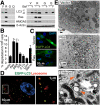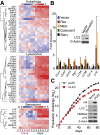Autophagy mediates the mitotic senescence transition
- PMID: 19279323
- PMCID: PMC2666340
- DOI: 10.1101/gad.519709
Autophagy mediates the mitotic senescence transition
Abstract
As a stress response, senescence is a dynamic process involving multiple effector mechanisms whose combination determines the phenotypic quality. Here we identify autophagy as a new effector mechanism of senescence. Autophagy is activated during senescence and its activation is correlated with negative feedback in the PI3K-mammalian target of rapamycin (mTOR) pathway. A subset of autophagy-related genes are up-regulated during senescence: Overexpression of one of those genes, ULK3, induces autophagy and senescence. Furthermore, inhibition of autophagy delays the senescence phenotype, including senescence-associated secretion. Our data suggest that autophagy, and its consequent protein turnover, mediate the acquisition of the senescence phenotype.
Figures





Comment in
-
Eating to exit: autophagy-enabled senescence revealed.Genes Dev. 2009 Apr 1;23(7):784-7. doi: 10.1101/gad.1795309. Genes Dev. 2009. PMID: 19339684
References
-
- Acosta J.C., O'Loghlen A., Banito A., Guijarro M.V., Augert A., Raguz S., Fumagalli M., Da Costa M., Brown C., Popov N., et al. Chemokine signaling via the CXCR2 receptor reinforces senescence. Cell. 2008;133:1006–1018. - PubMed
-
- Bartkova J., Rezaei N., Liontos M., Karakaidos P., Kletsas D., Issaeva N., Vassiliou L.V., Kolettas E., Niforou K., Zoumpourlis V.C., et al. Oncogene-induced senescence is part of the tumorigenesis barrier imposed by DNA damage checkpoints. Nature. 2006;444:633–637. - PubMed
Publication types
MeSH terms
Substances
Grants and funding
LinkOut - more resources
Full Text Sources
Other Literature Sources
Medical
Molecular Biology Databases
Research Materials
Miscellaneous
